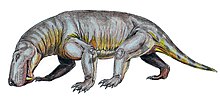ルビジア
| ルビジア | |||||||||||||||||||||||||||||||||
|---|---|---|---|---|---|---|---|---|---|---|---|---|---|---|---|---|---|---|---|---|---|---|---|---|---|---|---|---|---|---|---|---|---|
 Rubidgea atroxの頭蓋骨
| |||||||||||||||||||||||||||||||||
| 地質時代 | |||||||||||||||||||||||||||||||||
| 後期ペルム紀 | |||||||||||||||||||||||||||||||||
| 分類 | |||||||||||||||||||||||||||||||||
| |||||||||||||||||||||||||||||||||
| 学名 | |||||||||||||||||||||||||||||||||
| Rubidgea Broom, 1938 | |||||||||||||||||||||||||||||||||
| シノニム | |||||||||||||||||||||||||||||||||
|
属レベル
種レベル
| |||||||||||||||||||||||||||||||||
| 種 | |||||||||||||||||||||||||||||||||
|
ルビジア[1](学名:Rubidgea)またはルビジェア[2]は、後期ペルム紀のアフリカ大陸に生息した絶滅したゴルゴノプス科の属[1]。タイプ種はRubidgea atrox[3]。本属は後期ペルム紀に生息した派生的大型ゴルゴノプス類であるルビジア亜科に属しており、同亜科においても特に派生的である[1]。全長は3メートルとゴルゴノプス類の中ではイノストランケビアに迫る大型の属であり、また頑強な体格を持つ[1]。門歯は左右5本ずつで、また犬歯よりも後方の歯は小型かつ少数であった[1]。
発見の歴史
[編集]ルビジアの最初の化石は1930年代に古生物学者ジェームズ・キッチングの父 C. J. M. "Croonie" Kitchingが発見した。発見地は南アフリカ共和国東ケープ州のNieu-Bethesda郊外に位置するドゥーンバーグ農場であった。この発見は1938年に論文化され、ロバート・ブルームが化石をRubidgea kitchingiと命名した[4]。ブルームはこの新しいゴルゴノプス科の化石の大きさを特筆しており、新種であると主張した[5]。その後数十年に亘る発見を経て、ゴルゴノプス類の新しい亜科が設立されるべきであるというブルームの考えは賛同を受け、ルビジア亜科が設立に至った[6]。
特徴
[編集]
ルビジアはアフリカから化石が産出したゴルゴノプス類としては2016時点で最大の属であり[7]、ゴルゴノプス類全体においても史上最大級のものであった[1]。最大の標本では頭骨長が45センチメートル[1]または47センチメートルに達し[3]、後頭部の幅は吻部の3倍まで拡大する[1]。ルビジアは頑強な体格を持つ大型の頂点捕食者であり、上下に厚い頭蓋骨や長いサーベル状の犬歯を有した[8][9]。ルビジアが属するルビジア亜科はこうした頑強な骨格形態を持ち、また骨が高度に緻密化していることが特徴に挙げられる。ルビジア属には3種が分類されており、R. atrox、R. platyrhina、R. majoraがそれにあたる[7]。
分類
[編集]
ルビジア亜科は派生的なゴルゴノプス科のグループであり、アフリカ大陸でのみ化石が発見されている。ルビジア亜科は6属17種からなり、ロシアで化石が産出しているイノストランケビア亜科と姉妹群をなす。ルビジア亜科はゴルゴノプス類の中でも特異的な形態形質を示すため研究が進んでいるグループであり、他のゴルゴノプス類は頭蓋骨の形態形質が分類群間で似通っているため効果的な区別が難しい[10][11][12][13][14][15][16][17][18][19]。以下のクラドグラムはKammerer and Rubidge (2022)に基づき、ゴルゴノプス類の類縁関係を示す[20]。
| ゴルゴノプス亜目 |
| |||||||||||||||||||||||||||||||||||||||||||||||||||||||||||||||||||||||||||||||||||||||||||||||||||||||||||||||
層序と地理
[編集]ザンビアの上部マドゥアビサ泥岩層やマラウイのChiweta単層をはじめ、アフリカの盆地ではルビジア亜科のゴルゴノプス科を含む数多くの獣弓類の種が生物層序のマーカーとして用いられている[21]。ルビジアの化石がタンザニアのウシリ層から回収されたことからは、南アフリカ共和国とタンザニアとの間で上部ペルム系堆積物の生層序学的相関性が示唆される[22]。
なお、上記でロシアの分岐群の1つとして挙げたイノストランケビアであるが、2023年にはInostrancevia africanaという新種のイノストランケビアがアフリカから報告されている[2]。本種はアフリカでルビジア亜科が姿を消した後に頂点捕食者として出現したとみられており、ペルム紀の終わりにはアフリカでの頂点捕食者の交代を含む生態系シフトが発生していたことが示唆されている[2]。
出典
[編集]- ^ a b c d e f g h 土屋健『前恐竜時代 失われた魅惑のペルム紀世界』ブックマン社、2022年10月22日、133-134頁。ISBN 978-4-89308-953-3。
- ^ a b c “新種化石を定説覆す場所で発見、大量絶滅を逃れようと大移動か”. 日経ナショナルジオグラフィック (2023年6月6日). 2023年10月4日閲覧。
- ^ a b Gebauer, E. V. (2007). Phylogeny and Evolution of the Gorgonopsia with a Special Reference to the Skull and Skeleton of GPIT-RE-7113 ('Aelurognathus?'Parringtoni) (Ph.D. thesis) (英語). University of Tübingen.
- ^ Broom, Robert. "20. On a New Family of Carnivorous Therapsids from the Karroo Beds of South Africa." In Proceedings of the Zoological Society of London, vol. 108, no. 3, pp. 527-533. Oxford, UK: Blackwell Publishing Ltd, 1938.
- ^ Kitching, J. W. (1953) (英語). Studies on new specimens of the Gorgonopsia.
- ^ Cruickshank, A. R. I. (1973). “THE MODE OF LIFE OF GORGONOPSIANS” (英語). Palaeontologia Africana. ISSN 0078-8554.
- ^ a b Kammerer, Christian F. (2016-01-26). “Systematics of the Rubidgeinae (Therapsida: Gorgonopsia)” (英語). PeerJ 4: e1608. doi:10.7717/peerj.1608. ISSN 2167-8359. PMC 4730894. PMID 26823998.
- ^ Jenkins, Ian; Valkenburgh, Blaire Van (2002-10-01). “Evolutionary Patterns in the History of Permo-Triassic and Cenozoic Synapsid Predators” (英語). The Paleontological Society Papers 8: 267–288. doi:10.1017/S1089332600001121. ISSN 1089-3326.
- ^ Kermack, Doris M.; Kermack, Kenneth A. (1984), Kermack, Doris M.; Kermack, Kenneth A., eds., “Dentitions, Tooth-Replacement and Jaw Articulation” (英語), The Evolution of Mammalian Characters (Springer US): pp. 66–88, doi:10.1007/978-1-4684-7817-4_5, ISBN 9781468478174
- ^ Kemp T. S.; Parrington Francis Rex (1969-09-04). “On the functional morphology of the gorgonopsid skull”. Philosophical Transactions of the Royal Society B: Biological Sciences 256 (801): 1–83. Bibcode: 1969RSPTB.256....1K. doi:10.1098/rstb.1969.0036.
- ^ Sigogneau, D. (1968). “On the classification of the Gorgonopsia” (英語). Palaeontologia Africana. ISSN 0078-8554.
- ^ Sigogneau-Russell, D., 1989. Theriodontia 1: Phthinosuchia, Eotitanosuchia, Gorgonopsia.
- ^ Martins, Rui M. S.; Fröbisch, Jörg; Polcyn, Michael J.; Fernandez, Vincent; Araujo, Ricardo M. (2017-02-21). “Aspects of gorgonopsian paleobiology and evolution: insights from the basicranium, occiput, osseous labyrinth, vasculature, and neuroanatomy” (英語). PeerJ 5: e3119. doi:10.7717/peerj.3119. PMC 5390774. PMID 28413721.
- ^ Norton, Luke Allan (1 February 2013). Relative growth and morphological variation in the skull of Aelurognathus (therapsida: gorgonopsia) (Thesis thesis) (英語).
- ^ Gebauer, Eva V. I. (2014), “Re-assessment of the Taxonomic Position of the Specimen GPIT/RE/7113 (Sauroctonus parringtoni comb. Nov., Gorgonopsia)”, in Kammerer, Christian F.; Angielczyk, Kenneth D.; Fröbisch, Jörg (英語), Early Evolutionary History of the Synapsida, Vertebrate Paleobiology and Paleoanthropology, Springer Netherlands, pp. 185–207, doi:10.1007/978-94-007-6841-3_12, ISBN 9789400768413
- ^ Kammerer, Christian F. (2014), “A Redescription of Eriphostoma microdon Broom, 1911 (Therapsida, Gorgonopsia) from the Tapinocephalus Assemblage Zone of South Africa and a Review of Middle Permian Gorgonopsians”, in Kammerer, Christian F.; Angielczyk, Kenneth D.; Fröbisch, Jörg (英語), Early Evolutionary History of the Synapsida, Vertebrate Paleobiology and Paleoanthropology, Springer Netherlands, pp. 171–184, doi:10.1007/978-94-007-6841-3_11, ISBN 9789400768413
- ^ Kammerer, Christian F. (2015). “Cranial osteology of Arctognathus curvimola, a short-snouted gorgonopsian from the Late Permian of South Africa” (英語). Papers in Palaeontology 1 (1): 41–58. doi:10.1002/spp2.1002. ISSN 2056-2802.
- ^ Kammerer, Christian F.; Smith, Roger M. H.; Day, Michael O.; Rubidge, Bruce S. (2015). “New information on the morphology and stratigraphic range of the mid-Permian gorgonopsian Eriphostoma microdon Broom, 1911” (英語). Papers in Palaeontology 1 (2): 201–221. doi:10.1002/spp2.1012. ISSN 2056-2802.
- ^ Fröbisch, Jörg; Fernandez, Vincent; Kardjilov, Nikolay; Kammerer, Christian F.; Bendel, Eva-Maria (2018-11-28). “Cranial anatomy of the gorgonopsian Cynariops robustus based on CT-reconstruction” (英語). PLOS ONE 13 (11): e0207367. Bibcode: 2018PLoSO..1307367B. doi:10.1371/journal.pone.0207367. ISSN 1932-6203. PMC 6261584. PMID 30485338.
- ^ Kammerer, C. F.; Rubidge, B. S. (2022). “The earliest gorgonopsians from the Karoo Basin of South Africa”. Journal of African Earth Sciences 194: 104631. Bibcode: 2022JAfES.19404631K. doi:10.1016/j.jafrearsci.2022.104631.
- ^ Maisch, M.W., 2002. Observations on Karoo and Gondwana vertebrates. Part 3: Notes on the gorgonopsians from the Upper Permian of Tanzania. Neues Jahrbuch fur Geologie und Palaontologie-Monatshefte, (4), pp.237-251.
- ^ Parrington, F. R. "A new genus of gorgonopsid from East Africa." Annals of the South African Museum 64 (1974): 47-52.
